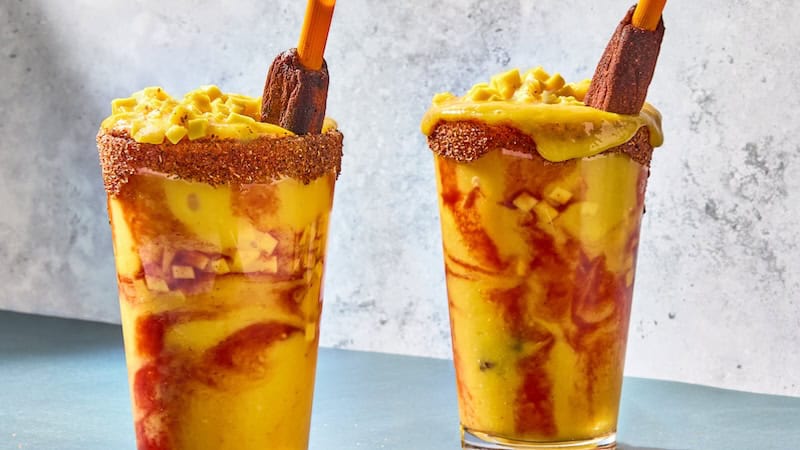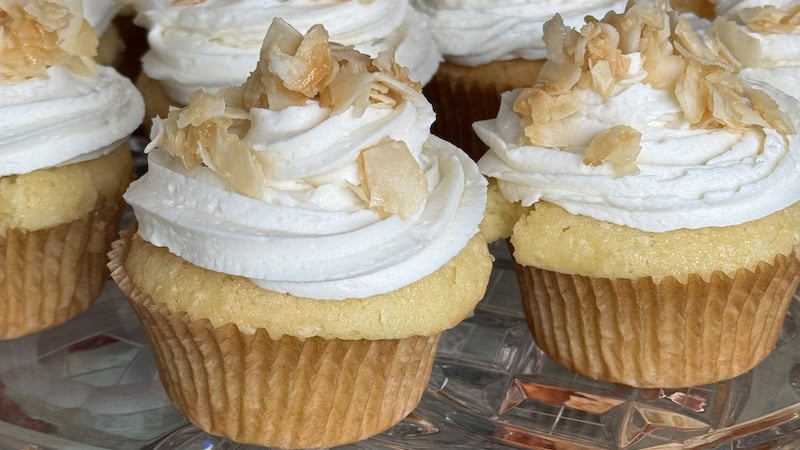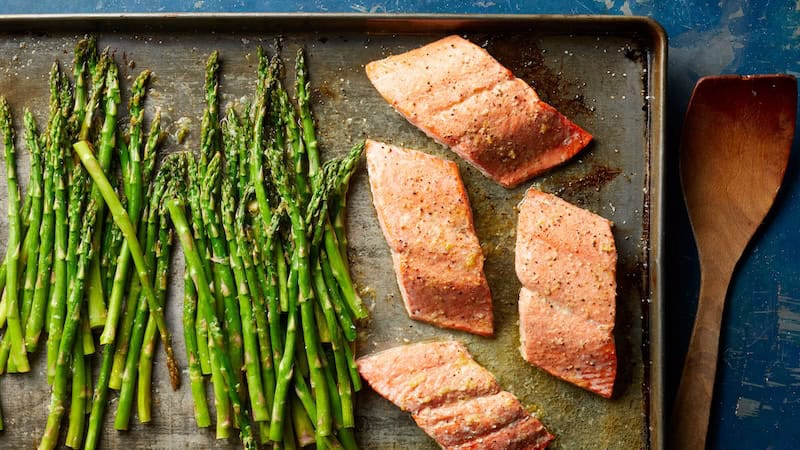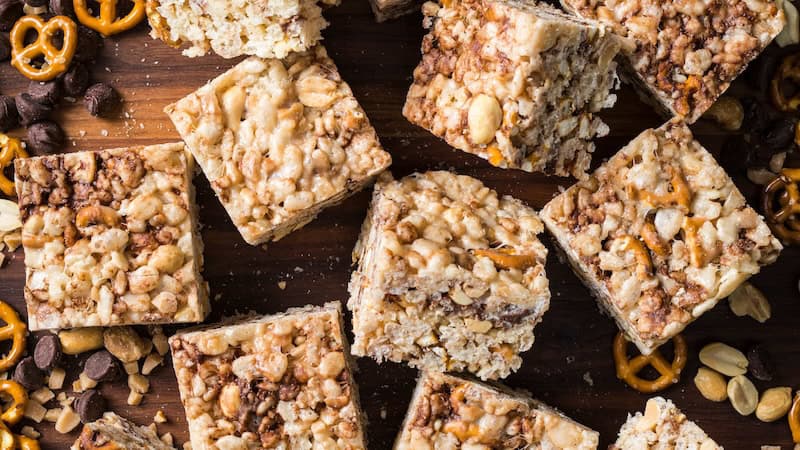The Mexican ‘Mangonada’
A ridiculously refreshing summertime sipper

If you ever find yourself in the markets of Mexico or a Mexican-American neighborhood during the summer, you’ll be sure to see fruit vendors dishing up iconic cups of sweet fruit covered in lime juice and chiles, which is a classic way to prepare fruit in Mexico. The Mexican mangonada is a sorbet-like frozen treat that combines sweet ripe mango, salty Tajín, and a sour sauce known as chamoy. It is emblematic of that culinary experience. This refreshing frozen treat is a tasty representation of how many Mexicans enjoy their fruit during the summer.
Why you’ll love a Mexican mangonada
It’s bound to be this summer’s staple drink. Macerating fresh mango draws out its natural juices and softens the fruit, giving you a smoother sorbet and juicy mango pieces.
- You don’t need to freeze any mangos. The only addition of water is in the form of ice. So there’s no need to freeze the mangos to wait for your mangonada experience.
- It’s sweet, salty, and sour. Chamoy, Tajín, and a tamarind chile straw add a salty-sour element that pairs well with the sweet mango.
- It’s got great texture. There are fresh pieces of macerated mango in the sorbet as well as on top, adding a textural element to the drink.
Key ingredients
- Ataulfo mangoes: This variety of mango, also known as Champagne mango, is (in my opinion) the most flavorful for mangonadas. They produce a silky-smooth, aromatic, and sweet sorbet. To check if they’re ripe, apply gentle pressure; if they have a slight give to them, they’re ready. The softer the mango, the more difficult it will be to peel and dice. The harder the mango, the less likely it is to macerate properly.
- Granulated sugar: Sugar is key to macerating the mangos, drawing out their natural juices to create a flavorful syrup.
- Tamarind straw: A fun garnish that you will see in most mangonadas across Mexico. Not only is it functional, but you can also eat the tamarind chile paste off the straw as you enjoy your mangonada.
- Chamoy: Adds a sour and salty element to the mangonada, which provides balance to the sweet flavors. Licking the chamoy off of the rim adds to the overall experience.
- Tajín: It’s the equivalent of a cherry on top! The citric acid in Tajín gives you that irresistible mouth-puckering feel.
The history of the Mexican mangonada
The origin of the drink is a bit murky, however most evidence and oral history points to Tijuana, Mexico, as the birthplace of the original frozen treat, where it began as a mango sorbet with a Tajín-rimmed glass and no chamoy inside. It soon after evolved into a chamoyada or chamango, which was when vendors started incorporating chamoy into the actual drink. It has since then been produced in the forms of raspados, paletas, and frozen drinks. The popularity of the frozen treat has spread so wide that there are chains of ice cream shops throughout the United States and Mexico that specialize in mangonada-inspired products.
Chamoy itself was introduced to Mexico by a Japanese businessman named Teikichi Iwadare. He immigrated to central Mexico in the 1920s and opened a store that sold Japanese food products. Chamoy was inspired by umeboshi, which is a pickled plum condiment Iwadare sold in his store. Umeboshi was loved by the Mexican community for its salty and acidic flavor profile. The condiment was adapted and, over time, chiles were added and it became chamoy.
Helpful swaps in a Mexican mangonada
- Instead of granulated sugar, you can also use brown sugar, natural cane, or monk fruit sugar as an alternative.
- There are sugar-free alternatives to chamoy available.
- If you don’t have fresh mango, you can use 2 pounds thawed frozen mango chunks. Cut into small dice before adding the sugar.
Steps for preparing the mango
- Using a Y peeler, peel the mango holding it upside down starting at the base and peeling towards the top. Create a flat surface at the base of the mango by peeling across the bottom until it is able to stand up once placed on a flat surface.
- With the mango standing up and the narrow part facing you, slice each side or “cheek” off. Do this by locating the middle point at the very top of the pit and then go to the left about 1/4 inch and slice down; if you hit seed just start all over again and curve your blade away from it. Repeat on the opposite cheek.
- Once the cheeks are cut off, take the mango and cut around the pit. There should be about 1/4 inch of flesh surrounding the edges of the pit. Gently glide your knife around the edge; you should be able to distinguish between flesh and pit.
- Place the mango cheeks flat-side down and, with the side of your knife facing the cutting board, slice them in half. Repeat with all mango cheeks.
- Slice longways into 1/4-inch slices and then rotate the mango to do the same, which will create 1/4 squares. Repeat for the long strips that you cut off the edges of the mango.
Mexican Mangonada
Serves 6
Ingredients:
- 4 pounds ripe mangos, preferably Ataulfo or “Champagne”
- 1/4 cup plus 2 tablespoons granulated sugar
- 3 medium limes
- 5 cups ice, divided
- 3 tablespoons chamoy (Mexican pickled fruit sauce), plus more for drizzling
- 2 tablespoons Tajín Clásico, plus more for sprinkling
- 6 straws or tamarind-chile candy sticks
Directions:
- Peel 4 pounds ripe mangos, preferably with a Y-shaped peeler. Pit and cut the mangoes into small (1/4-inch) dice (about 9 cups). Place in a large bowl.
- Add 1/4 plus 2 tablespoons granulated sugar and gently mix until combined. Let sit for 10 minutes for the sugar to begin to dissolve. Stir again, then let sit for at least 5 and up to 50 minutes more. Meanwhile, juice 3 medium limes until you have 1/4 cup. Place 3 tablespoons chamoy sauce on a small flat plate. Place 2 tablespoons Tajín Clásico on a second small flat plate.
- Reserve 3/4 cup of the mango for assembling. Place half of the remaining mango, half of the lime juice, and 2 1/2 cups ice in a blender. Blend on low speed for 20 seconds, then gradually increase the speed to medium and blend for 20 seconds. Increase the speed to high and blend until the texture of a thick smoothie, about 20 seconds more. Pour into a pitcher and repeat blending the remaining mango, lime juice, and ice together. Stir the mangonada in the pitcher to blend the batches together.
- Rim six (12-ounce) glasses one at a time: Invert the glass into the chamoy, turning it as needed, to coat the rim. Turn it on its side and coat the top inch or so of the outside of the glass in the chamoy. Repeat inverting the glass and rimming it with the Tajín, using a small spoon to dust some of the Tajín onto the chamoy as needed. Drizzle some of the chamoy into each glass, letting it run down the sides.
- Fill the glasses halfway with the mangonada. Top each with 1 tablespoon reserved mango. Fill the glasses up with the remaining mangonada. Garnish with the remaining reserved mango and Tajín, and serve with a regular straw or tamarind chile candy stick (cut or bite the ends off the candy stick first to use as a straw).
Related: Crispy Chicken and Chorizo Tacos and Chile-Spiked Sorbet
Tony Ortiz is a contributor to TheKitchn.com, a nationally known blog for people who love food and home cooking. Submit any comments or questions to editorial@thekitchn.com.
©2024 Apartment Therapy. Distributed by Tribune Content Agency, LLC.


